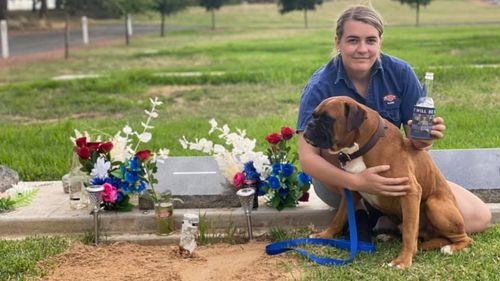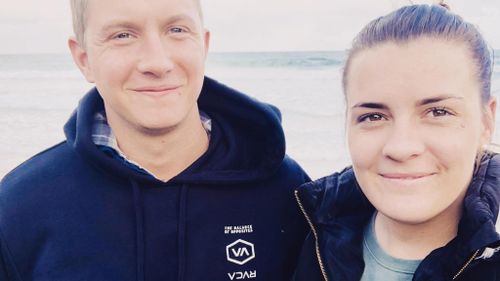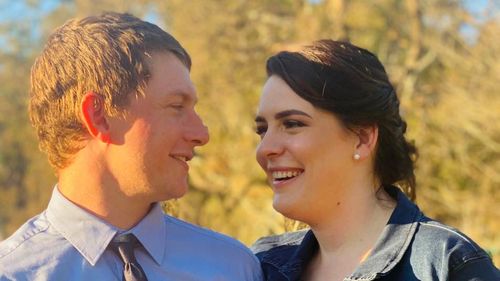Last weekend would have been Madeline Botts’ wedding day.
But instead of trying the knot in Fiji she spent the afternoon sitting by her fiancé Ethan Hunter’s grave telling him how much she missed him.
Mr Hunter, 27, and his work colleague Mark Fenton, 50, were both killed last month at a level crossing in Bribbaree, a small rural town about 400km west of Sydney.
The pair were carting gypsum as a favour for Mr Hunter’s cousin when a freight train collided with their B-double truck.

Ms Botts said nothing could take the pain of her loss away.
“Ethan and I have been together since I was 18. He is just the most beautiful, kind, selfless person. Everyone who met him he made an impression on,” she said.
But even as she reels from her tragic and sudden loss, Ms Botts is on a mission – to make sure no-one else will have to go through the same pain as her.
According to the Australian Rail Track Corporation (ARTC), just 21 per cent of the 23,500 level crossings in Australia have either boom gates or flashing lights to alert a driver when a train is coming.

The level crossing where Mr Hunter and Mr Fenton were killed is one of the remaining 79 per cent which are passive, meaning they are only marked by a stop or give way sign.
Ms Botts said both her fiancé and Mr Fenton were extremely responsible people and would never have knowingly taken any risks at the level crossing.
The crossing where the accident happened was “not safe at all”, Ms Botts said, with the view of the train tracks being at least partially obscured.
“Where the crash happened on the left-hand side it’s got trees blocking the view and it’s got overgrown grass as well,” she said.

Almost a year to the day Mr Hunter was killed, a man was seriously injured in another accident at a level crossing less than a kilometre away, Ms Botts said.
Until recently, level crossing collisions were causing about 30 deaths per year in Australia, the ARTC says.
The number of fatalities is declining but there are still multiple level crossing deaths every year and collisions resulting in serious injuries.
In Victoria, the Labor State Government has committed to removing 75 of the most dangerous level crossings across metropolitan Melbourne by 2025 and has so far gotten rid of 46.

In NSW, 63 per cent of the state’s 1360 level crossings have active traffic controls.
Tara McCarthy, the Executive Director of Safety, Environment and Regulation at Transport for NSW, said level crossing safety was “an important area of focus for Transport for NSW and part of our effort to drive the road toll towards zero”.
Every year, the NSW Government spent $7.3 million toward accelerating upgrades of priority level crossings and also education and enforcement campaigns run in conjunction with NSW Police, she said.
However, Ms Botts said much more needed to be done.
“I have been reading a lot of coronial inquest reports into level crossing accidents. It’s been recommended as far back as 2004 that if a level crossing can’t be removed then they need to be made as safe as possible,” she said.
“The recommendations for that are lights at crossings, making trains more visible and some sort of system that can let a driver know a train is coming by sending something to their phone or on their radio.
“It’s just hard to accept that that is not happening when its 2021 and the recommendations were made in 2004.
“You just can’t put a price tag on anyone’s life. Whatever it costs it is worth it. Ethan and Mark were both remarkable men who are missed so much.
“We can’t bring them back but we are just trying to prevent people from ever feeling how we feel.”
Contact reporter Emily McPherson at emcpherson@nine.com.au.
This content first appear on 9news
